Students can access the CBSE Sample Papers for Class 11 Biology with Solutions and marking scheme Term 2 Set 5 will help students in understanding the difficulty level of the exam.
CBSE Sample Papers for Class 11 Biology Term 2 Set 5 for Practice
Time : 2 Hours
Maximum Marks : 35
General Instructions:
- All questions are compulsory.
- The question paper has three sections of 23 questions. All questions are compulsory.
- Section-A has 6 questions of 2 marks each; Sedion-B has 6 questions of 3 marks each, and Section-C has a case-based question of 5 marks.
- There is no overall choice. However, internal choices have been provided in some questions. A student has to attempt only one of the alternatives in such questions.
- Wherever necessary, neat and properly labeled diagrams should be drawn.
![]()
Section – A
(2 Marks)
Question 1.
Answer the following questions based on the equation given below:
2H2O → 2H+ + O2 + 4e–
(a) Where in plants does this reaction occur?
(b) What is the importance of this reaction?
Question 2.
Study the pathway given below.
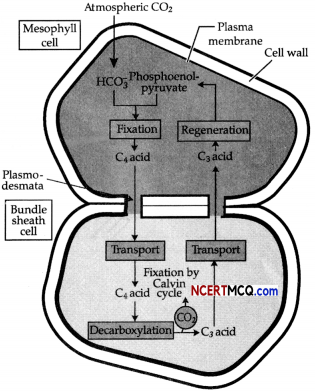
(a) Which group of plants exhibits these two types of cells? What is the first product of C4 cycle? (1)
(b) Which enzyme is there in bundle sheath cells and mesophyll cells?
OR
Six turns of Calvin cycle are required to generate one mole of glucose. Explain.
![]()
Question 3.
The figure given below shows the stages of ripening in a banana.
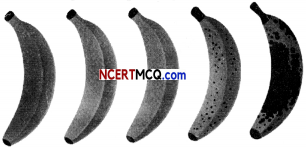
(a) Name the plant hormone responsible for the above changes.
(b) Mention the site of synthesis as well as function of this hormone.
Question 4.
An aquarium fish and a pigeon were fed on protein diet.
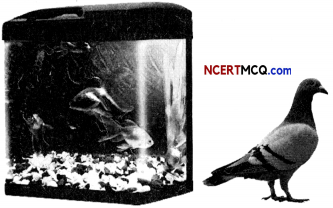
(a) Which group of plants exhibits these two types of cells? What is the first product of C4 cycle? (1)
(b) Which enzyme is there in bundle sheath cells and mesophyll cells? (1)
OR
(a) In what different forms would they excrete their nitrogenous wastes? (1)
(b) Why do they excrete so differently? (1)
![]()
Question 5.
The pressure exerted by an individual gas in a mixture of gases is called partial pressure. It is directly proportional to its concentration in a mixture. It is expressed as pO2, pCO2, etc.
(a) How does it help in gaseous exchange during respiration? (1)
(b) State the pO2 and pCO2 in the blood after tissue respiration. (1)
Question 6.
The diagram alongside represents the simplified pathway of the circulation of blood.

(a) Name the blood vessels labelled 1 and 2. (1)
(b) State the function of blood vessels labeled 5 and 8. (1)
OR
The diagram given alongside represents the human heart in one phase of its functional activities. Study the same and answer the questions that follow:

(a) Name the phase. Which part of the heart is contracting in this phase?
(b) Label the parts A, B and C.
![]()
Section – B
(3 Marks each)
Question 7.
In a certain ‘X’ organism, a process is occurring throughout the day in which cells are participating. Water, ATP and carbon dioxide are evolved during the process and is not light-dependent process.
(a) Which process is discussed above? (1)
(b) Is this a catabolic or anabolic process? (1)
(c) Write the raw materials required for this process. (1)
Question 8.
The final product of glycolysis is pyruvic acid. Write the three metabolic fates of the pyruvic acid in anaerobic and aerobic conditions as seen in the diagram below:
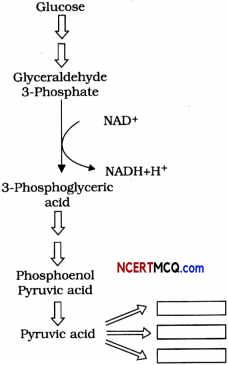
The diagram below shows ATP synthesis through chemiosmosis.
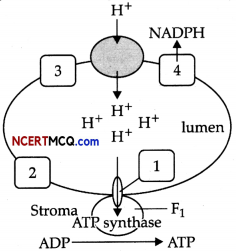
(a) Label the parts 1, 2, 3 and 4 in the diagram? (2)
(b) What role is played by ATPase? (1)
![]()
Question 9.
The lymphatic system in the human body is made up of lymph, lymphatic vessels, lymphatic nodes, and lymphoid tissue. What is the functional role of the lymphatic system?
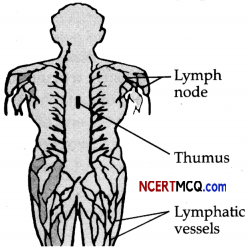
Question 10.
Unlike plant hormones, animal hormones are often produced in specialized hormone-synthesizing glands. The hormones are then secreted from the glands into the blood stream, where they are transported throughout the body.
(a) List the endocrine gland that is absent in males and the one absent in the female. (1)
(b) Which is the endocrine gland that secretes calcitonin? What role does this hormone play? (1)
(c) Why do old people have a weak immune system? (1)
![]()
Question 11.
The given diagram represents the structure of human brain. The brain is the central information processing organ of our body, and acts as the ‘command and control system’. It controls the voluntary movements; balance of the body, thermoregulation, and the brain also processes vision, hearing, speech, etc. The brain can be divided into three parts : Forebrain, Midbrain and Hindbrain.
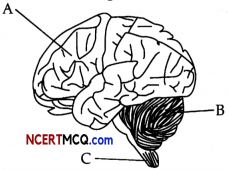
(a) Where in the human brain is the centre for hunger located? (1)
(b) List the names of any two structures that protect the brain. (1)
(c) What does the white and grey matter in the human brain indicate? (1)
![]()
Question 12.
The figure given below shows a part of a nephron.
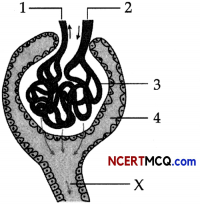
(a) In which region of the kidney is the above structure present? (1)
(b) What is the technical term used for the process that occurs in part 3? (1)
(c) Why is fluid X not called urine? Justify your answer. (1)
Section – C
(5 Marks)
Question 13.
The completion of prophase is marked by the following characteristic events :
Chromosomal material condenses to form compact mitotic chromosomes. They are seen to be composed of two chromatids attached together at the centromere. Centrosome which had undergone duplication during interphase, begins to move towards opposite poles of the cell. They radiate out microtubules called asters. The two asters together with spindle fibres form mitotic apparatus. Cells at the end of prophase do not show Golgi complexes, endoplasmic reticulum, nucleolus and the nuclear envelope.
![]()
(a) Which phase of mitosis is the starting point of metaphase? (1)
(b) Nuclear membrane disappears in meiosis at the end of which stage? (1)
(c) Which term is used to refer the stage between two meiotic divisions? (1)
(d) What is crossing over? At which stage of meiosis I it takes place? (2)
OR
A cell, which has 32 chromosomes, undergoes mitotic division.

(a) What will be the chromosome number (N) during metaphase? (1)
(b) What would be the DNA content (C) during anaphase? (1)
(c) Draw a labeled diagram of anaphase of mitosis. Write any two key features of this phase. (3)